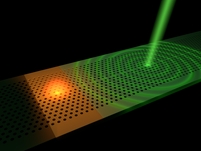September 16, 2014
Researchers from Eindhoven University of Technology can now for the first time remotely control a miniature light source at timescales of 200 trillionth of a second. They published the results on 14 September 2014 in the journal Nature Nanotechnology.
Physicists from the Photonics and Semiconductor Nanophysics group at Eindhoven, under the leadership of FOM workgroup leader professor Andrea Fiore, have developed a way of remotely controlling the nanoscale light sources at an extremely short timescale. These light sources are needed to be able to transmit quantum information.
The researchers etched a photonic crystal around several quantum dots in a semiconductor layer. Quantum dots are small structures that spontaneously emit light as a consequence of atomic processes. If a short laser pulse is fired at the quantum crystal then its refractive index is briefly disrupted and the quantum dot experiences a change in the electromagnetic field around it. This change can speed up or slow down the emission of light by the dot. As soon as the disruption has stopped the dot will emit light again in the normal manner.
Ultrashort light flash
Using this technique the spontaneous emission of light by the dot can be switched on and off at will. The most striking thing about this method is that the duration of the light flash can be made considerably shorter than the natural lifespan of such a dot as a light source. In the current article the researchers describe an experiment in which the light pulse was 200 picoseconds (trillionths of a second) long. Based on the underlying theory, however, the researchers expect to be able to make these light pulses a factor of ten shorter still. Furthermore, the researchers discovered that the emission of the light source could be controlled using a laser pulse at a relatively large distance from the source.
Quantum information
This research result is important for the transmission of quantum information, for example. This requires light sources that can emit individual photons (light particles). Being able to control time-dependent properties of these photons is important for the exchange of quantum information between different parties. The method now proposed for the remote control of the light source makes this possible without influencing the properties of the light particles emitted.
The researchers used the NanoLab@TU/e facilities to make the special structure that holds a quantum dot in a photonic crystal. The research was funded by NanoNextNL, STW and FOM.
Reference
Ultrafast nonlocal control of spontaneous emission, Chao-Yuan Jin, Robert Johne, Milo Y. Swinkels, Thang B. Hoang, Leonardo Midolo, Peter J. van Veldhoven, and Andrea Fiore.
The article is available at Nature Nanotechnology http://dx.doi.org/10.1038/nnano.2014.190













